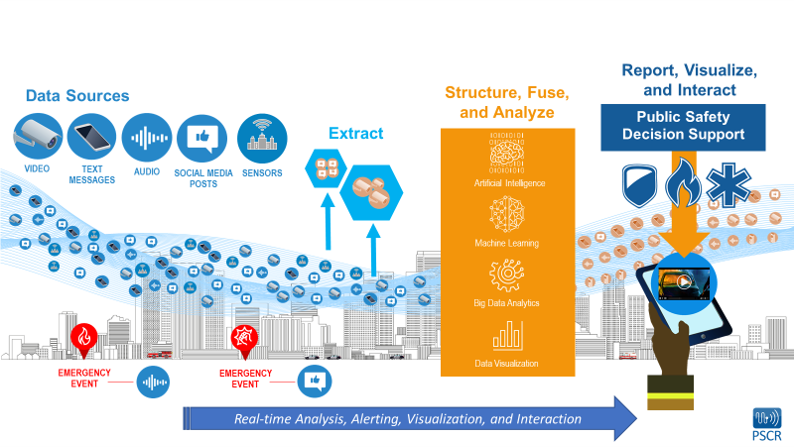2020 Automated Streams Analysis for Public Safety (ASAPS) Challenge & the ASAPS Dataset

2020 Automated Streams Analysis for Public Safety Prize Challenge
The Automated Streams Analysis for Public Safety (ASAPS) Prize Challenge was an open innovation program focused on the development of algorithms to detect and analyze a variety of emergency events from unstructured public safety data in real time. The increasing magnitude of live data from a variety of sources presents both a challenge and opportunity to public safety in making life-critical decisions regarding response and coordination to emergencies. The ASAPS Challenge was an artificial intelligence (AI) challenge to detect, analyze, and alert public safety to emergencies from streaming data where every second counts. ASAPS fostered groundbreaking multidisciplinary research and innovation in real-time emergency data analytics using a first-of-its-kind data set of unstructured video, audio, textual communications, social media, and sensors.
The challenge was segmented into a series of contests, detailed here: https://www.nist.gov/publications/automated-streams-analysis-public-safety-asaps-challenge-program. ASAPS Contest 1 began in May 2020 and concluded in September 2020. This contest was designed to "kick-off" the ASAPS Challenge by assessing today's state-of-the-art and envisioning new ideas to better leverage multi-modal data streams and real-time data processing to support public safety's mission. NIST originally planned for three follow-on prize competitions; however, in place of follow-on contests, NIST released the ASAPS Development Data for open research. The robust dataset includes eight continuous hours of over 40 multimodal data streams annotated for 62 emergency events and their corresponding evidence.
ASAPS Contest 1 Winners
ASAPS Contest 1 concluded with six awards of $30,000 each to top contestants, totaling $180,000 for the most compelling ideas. Learn more about the winning contestants and their entries below:
| Topic | Prize Awarded (Fall 2020) | Submission Title | Team Members |
| Topic 1: Information Extraction Across ASAPS Streams and Data Sources Across 1 or More Data Categories | $30,000 | Multimodal Fusion for Public Safety Analytics | Dan Morozoff, Joe Ellis, Gianni, Peter Njenga (Vidrovr), Connor O'Day |
| Topic 2: Information Fusion Across Extracted Data and Generation of Live/Dynamic Information Representation Across 3 or More Data Categories | $30,000 | Scalable Data Fusion for Real-Time Event Detection | Mehmet Aktukmak, Keval Doshi (University of South Florida), Yasin Yilmaz |
| Topic 2: Information Fusion Across Extracted Data and Generation of Live/Dynamic Information Representation Across 3 or More Data Categories | $30,000 | Balancing Space and Time with Asynchronous Models | Jason Corso (University of Michigan), Chenliang Xu (University of Rochester), Yan Tom Yan (Texas State University) |
| Topic 3: Automated Emergency Event Analysis Across 3 or More Data Stream Categories, and Preferably Across All Data Categories | $30,000 | NEURATRACE: Detect, Trace, & Analyze Emergencies | Madhukar Karmacharya, Kumar Apurv, Ananth BhimiReddy, Aamir Kahn, Archith Krishnan Rammohan, SaiManoharReddy Peddireddy (Indiana University/Indiana Purdue University), Sahitesh Reddypelly |
| Topic 4: Extraction to Analysis Systems Approach Across All Data Categories | $30,000 | Modular Design for Automated Event Analysis | Dr. Roy Hayes Jr., Admiral Guy Curtis, Roy Hayes Sr., William Kimbark, Sreya Palnati, Tom Slattery (Systems Engineering Inc.) |
| Topic 4: Extraction to Analysis Systems Approach Across All Data Categories | $30,000 | Real-Time Multi-Source Event Analytics | Alexander G. Hauptmann (CMU), Junwei Liang (CMU), Mubarak Shah (UCF), Yogesh Singh Rawat (UCF), Praveen Tirupattur (UCF), Shruti Vyas (UCF) |

Automated Streams Analysis for Public Safety (ASAPS) Dataset
The Automated Streams Analysis for Public Safety (ASAPS) Dataset includes eight continuous hours of data from across a fictitious ASAPS City representative of a normal day in a small city. The first-of-its-kind dataset represents a geographic area of approximately 68 square blocks. All of the GPS coordinates represent a fictitious location which includes 390 buildings and parks, each with an identity/name, street address, and latitude/longitude location. The dataset combines video recordings of staged emergencies with scripted audio and textual public safety communications and simulated Computer Aided Dispatch and gunshot sensor data. It was constructed to represent a continuous eight-hour snapshot of the emergencies happening during the day in a small city and includes 45 time-synchronized data streams.
NIST will consider requests for data in accordance with the terms and conditions of the data use agreement. Please review the readme and data use agreement in detail before requesting this data. As the funding resources to distribute the dataset are limited - NIST cannot support unlimited data downloads. If there are multiple individuals within the same organization using the dataset, NIST will allow for individuals who have completed their registration and acceptance of the data use agreement and who are employed by the same organization to share one copy of the dataset to reduce logistics burdens and costs. If your organization is collaborating with subcontractors or any other parties outside your organization, those subcontractors and other parties are required to register and sign a data use agreement. These subcontractors or other parties outside your organization are independent under this data use agreement. As a responsible data user, please plan ahead to ensure the limited NIST resources available to distribute this data are not diminished by unnecessary or redundant data requests.

